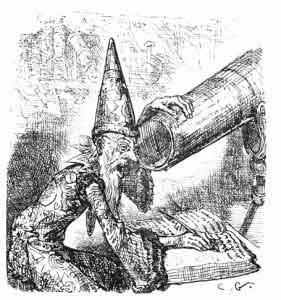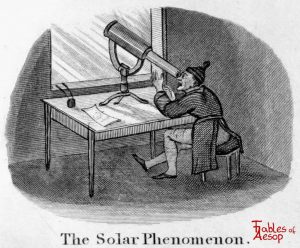An Astronomer observed an animal on the Sun and calculated all manner of characteristics. A doubter examined the instrument. Fly on the lens. Ooops!
Extraordinary claims need extraordinary proof.

JBR Collection
An Astronomer was observing the Sun through a telescope, in order to take an exact copy of the several spots which appear upon the face of it. While he was intent upon his observations, he was on a sudden surprised with a new and astonishing appearance; a large portion of the Sun was at once covered by a Monster of enormous size and horrible form. It had an immense pair of wings, a great number of legs, and a long and vast proboscis; and that it was alive was very apparent, from its quick and violent motions, which the observer could, from time to time, plainly perceive. Being sure of the fact (for how could he be mistaken in what he saw so clearly?), our Philosopher began to draw many surprising conclusions from premises so well established. He calculated the magnitude of this extraordinary animal, and found that it covered about two square degrees of the Sun’s surface; that placed on the earth, it would spread over half one hemisphere of it, and that it was seven or eight times as big as the moon. But what was most astonishing was the prodigious heat that it must endure. It was plain that it was something of the nature of the salamander, but of a far more fiery temperament; for it was demonstrable from the clearest principles that, in its present situation, it must have acquired a degree of heat two thousand times exceeding that of red-hot iron. In the earnest pursuit of these, and many similar deep and curious speculations, the Astronomer was engaged, and was preparing to communicate them to the public. In the meantime, the discovery began to be much talked of, and all the virtuosi gathered together to see so strange a sight. They were equally convinced of the accuracy of the observation, and of the conclusions so clearly deduced from it. At last one, more cautious than the rest, was resolved, before he gave a full assent to the report of his senses, to examine the whole process of the affair, and all the parts of the instrument. He opened the telescope, and, behold! a small Fly was enclosed in it, which, having settled on the centre of the object-glass, had given occasion to all this marvellous theory.

Jefferys Taylor (The Solar Phenomenon)
AN astronomer gazing, as oft he had done,
Through a very long telescope aim’d at the sun,
Descried, on a sudden, a spot on his face,
So large as to darken one third of his rays!
“Oh! Newton, Oh! Halley, were ye but alive,
What name to this monster, I ask, would you give?
Like no other spot on his disc does it seem;
As maculae, faculae*, neither of them.
But what do I see? the phenomenon moves,
And there are its legs too, which certainly proves
That it must be an animal:—awful indeed!
For its length half a million of miles must exceed:
If so, then the question must needs be decided,
Which has for so long all the learned divided;
For now tis as plain as the nose on my face,
That the sun is in truth an inhabited place!—
Oh, all ye philosophers, moralists, sages,
Who have puzzled your brains on this subject for ages;
Old Thales, Copernicus, Newton, Descartes,
Draw near, if ye can, and the truth I’ll impart.”
He ceased; but he scarcely an ending had made,
When the shades of those worthies his summons obey’d;
And, in low hollow voice, demanded in haste,
For what reason he’d call’d them, and broken their rest.
“Oh, indeed! are ye come?” said our hero, surprised,
“Why I did not suppose, as ye all had demised,
What I said could have reach’d you; but as it is so,
Forthwith I’ll proceed the huge monster to show;
So saying, to each he the telescope handed,
And quickly of each his opinion demanded.
Said Newton, “Some creature there is I suppose,
But I do not believe ’tis a yard from your nose!”
“Nor I,” said Copernicus, Thales, and all;
“In fact we believe ’tis no wonder at all!”
“Then pray,” said our hero, “explain what you see,
And say what you take this appearance to be.”
Said Newton, “Unscrew the last lens from your glass;”
The astronomer quickly obey’d, and, alas!
For his fame and his theory—what should he descry,
When he open’d the end of his tube,—but a fly!
Examine them well, ere you speak of new wonders:
‘Twill save you from many ridiculous blunders.
* Maculae and faculae, are names given by astronomers to the
dark and the bright spots seen occasionally on the sun’s disc.

